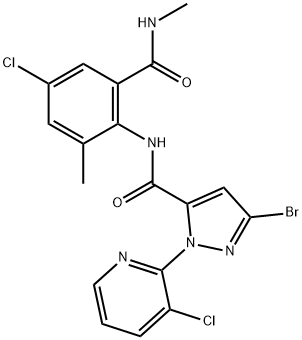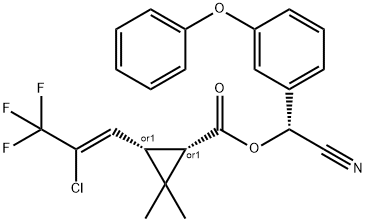Chlorantraniliprole , Analysis standard , 500008-45-7
Synonym(s):
3-Bromo-N-[4-chloro-2-methyl-6-[(methylamino)carbonyl]phenyl]-1-(3-chloro-2-pyridinyl)-1H-pyrazole-5-carboxamide;3-Bromo-4′-chloro-1-(3-chloro-2-pyridyl)-2′-methyl-6′-(methylcarbamoyl)pyrazole-5-carboxanilide;DPX E2Y45
CAS NO.:500008-45-7
Empirical Formula: C18H14BrCl2N5O2
Molecular Weight: 483.15
MDL number: MFCD11840831
PRODUCT Properties
| Melting point: | approximate 225℃ (dec.) |
| Boiling point: | 526.6±50.0 °C(Predicted) |
| Density | 1.66±0.1 g/cm3(Predicted) |
| storage temp. | 2-8°C |
| solubility | Chloroform: Slightly Soluble; DMSO: Slightly Soluble |
| form | A solid |
| pka | 10.19±0.70(Predicted) |
| color | White to off-white |
| InChI | InChI=1S/C18H14BrCl2N5O2/c1-9-6-10(20)7-11(17(27)22-2)15(9)24-18(28)13-8-14(19)25-26(13)16-12(21)4-3-5-23-16/h3-8H,1-2H3,(H,22,27)(H,24,28) |
| InChIKey | PSOVNZZNOMJUBI-UHFFFAOYSA-N |
| SMILES | N1(C2=NC=CC=C2Cl)C(C(NC2=C(C(NC)=O)C=C(Cl)C=C2C)=O)=CC(Br)=N1 |
| LogP | 3.641 (est) |
| CAS DataBase Reference | 500008-45-7 |
| EPA Substance Registry System | 1H-Pyrazole-5-carboxamide, 3-bromo-N-[4-chloro-2-methyl-6-[(methylamino)carbonyl]phenyl]-1-(3-chloro-2-pyridinyl)- (500008-45-7) |
Description and Uses
Chlorantraniliprole is an anthranilic diamide insecticide and agonist of ryanodine receptors located on the sarcoplasmic reticulum in muscle and endoplasmic reticulum in non-muscle cells. It binds to a different site than ryanodine on the receptor and stimulates the release of calcium from intracellular stores with EC50 values ranging from 40 to 50 nM for P. americana neurons and H. virescens or D. melanogaster recombinant ryanodine receptors. It is highly selective for insect over mammalian ryanodine receptors (EC50s = 14,000 nM, >100 μM, and >100 μM for C2C12 mouse, PC12 rat, and IMR32 human cells, respectively). Chlorantraniliprole is active against insects of the order Lepidoptera, including larvae of the fall armyworm (S. frugiperda), diamondback moth (P. xylostella), and tobacco budworm (H. virescens) with EC50 values of 0.02, 0.01, and 0.05 ppm, respectively, and of the orders Coleoptera, Diptera, and Isoptera. Formulations containing chlorantraniliprole have been used in agriculture to control moths, beetles, and caterpillars among other insects.
Chlorantraniliprole is a pyrazolylpyridine insecticide and an activator of insect ryanodine receptor. Used in Pesticide detection. (Solution)
Safety
| Symbol(GHS) |  GHS09 |
| Signal word | Warning |
| Hazard statements | H410 |
| Precautionary statements | P273-P391-P501 |
| Hazard Codes | Xn |
| Risk Statements | 22-36/37 |
| Safety Statements | 26 |
| Hazardous Substances Data | 500008-45-7(Hazardous Substances Data) |




